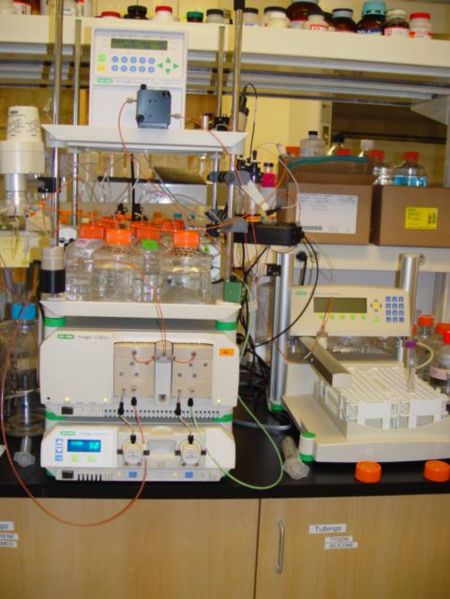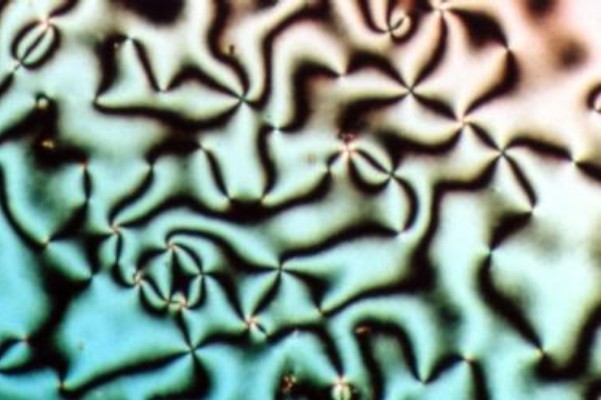|
Lauryldimethylamine Oxide
Lauryldimethylamine oxide (LDAO), also known as dodecyldimethylamine oxide (DDAO), is an amine oxide–based zwitterionic surfactant, with a C12 (dodecyl) alkyl tail. It is one of the most frequently-used surfactants of this type. Like other amine oxide–based surfactants it is antimicrobial, being effective against common bacteria such as '' S. aureus'' and ''E. coli'', however, it is also non-denaturing and can thus be used for protein purification. At high concentrations, LDAO forms liquid crystalline phases. Despite having only one polar atom that is able to interact with water – the oxygen atom (the quaternary nitrogen atom is hidden from intermolecular interactions), DDAO is a strongly amphiphilic surfactant: it forms normal micelle A micelle () or micella () ( or micellae, respectively) is an aggregate (or supramolecular assembly) of surfactant amphipathic lipid molecules dispersed in a liquid, forming a colloidal suspension (also known as associated colloidal sy ... [...More Info...] [...Related Items...] OR: [Wikipedia] [Google] [Baidu] |
Amine Oxide
In chemistry, an amine oxide, also known as an amine ''N''-oxide or simply ''N''-oxide, is a chemical compound that has the chemical formula . It contains a nitrogen-oxygen coordinate covalent bond with three additional hydrogen and/or substituent-groups attached to nitrogen. Sometimes it is written as or, alternatively, as . In the strict sense, the term ''amine oxide'' applies only to oxides of tertiary amines. Sometimes it is also used for the analogous derivatives of primary and secondary amines. Examples of amine oxides include pyridine-''N''-oxide, a water-soluble crystalline solid with melting point 62–67 °C, and ''N''-methylmorpholine ''N''-oxide, which is an oxidant. Applications Amine oxides are surfactants commonly used in consumer products such as shampoos, conditioners, detergents, and hard surface cleaners. Alkyl dimethyl amine oxide (chain lengths C10–C16) is the most commercially used amine oxide. They are considered a high production volume class o ... [...More Info...] [...Related Items...] OR: [Wikipedia] [Google] [Baidu] |
Zwitterionic Surfactant
Surfactants are chemical compounds that decrease the surface tension or interfacial tension between two liquids, a liquid and a gas, or a liquid and a solid. The word ''surfactant'' is a blend of "surface-active agent", coined in 1950. As they consist of a water-repellent and a water-attracting part, they enable water and oil to mix; they can form foam and facilitate the detachment of dirt. Surfactants are among the most widespread and commercially important chemicals. Private households as well as many industries use them in large quantities as detergents and cleaning agents, but also for example as emulsifiers, wetting agents, foaming agents, antistatic additives, or dispersants. Surfactants occur naturally in traditional plant-based detergents, e.g. horse chestnuts or soap nuts; they can also be found in the secretions of some caterpillars. Today one of the most commonly used anionic surfactants, linear alkylbenzene sulfates (LAS), are produced from petroleum product ... [...More Info...] [...Related Items...] OR: [Wikipedia] [Google] [Baidu] |
Antimicrobial
An antimicrobial is an agent that kills microorganisms (microbicide) or stops their growth (bacteriostatic agent). Antimicrobial medicines can be grouped according to the microorganisms they are used to treat. For example, antibiotics are used against bacteria, and antifungals are used against fungi. They can also be classified according to their function. Antimicrobial medicines to treat infection are known as antimicrobial chemotherapy, while antimicrobial drugs are used to prevent infection, which known as antibiotic prophylaxis, antimicrobial prophylaxis. The main classes of antimicrobial agents are disinfectants (non-selective agents, such as bleach), which kill a wide range of microbes on surfaces to prevent the spread of illness, antiseptics which are applied to living tissue and help reduce infection during surgery, and antibiotics which destroy microorganisms within the body. The term ''antibiotic'' originally described only those formulations derived from living microorga ... [...More Info...] [...Related Items...] OR: [Wikipedia] [Google] [Baidu] |
Staphylococcus Aureus
''Staphylococcus aureus'' is a Gram-positive spherically shaped bacterium, a member of the Bacillota, and is a usual member of the microbiota of the body, frequently found in the upper respiratory tract and on the skin. It is often positive for catalase and nitrate reduction and is a facultative anaerobe, meaning that it can grow without oxygen. Although ''S. aureus'' usually acts as a commensal of the human microbiota, it can also become an opportunistic pathogen, being a common cause of skin infections including abscesses, respiratory infections such as sinusitis, and food poisoning. Pathogenic strains often promote infections by producing virulence factors such as potent protein toxins, and the expression of a cell-surface protein that binds and inactivates antibodies. ''S. aureus'' is one of the leading pathogens for deaths associated with antimicrobial resistance and the emergence of antibiotic-resistant strains, such as methicillin-resistant ''S. aur ... [...More Info...] [...Related Items...] OR: [Wikipedia] [Google] [Baidu] |
Protein Purification
Protein purification is a series of processes intended to isolate one or a few proteins from a complex mixture, usually Cell biology, cells, Tissue (biology), tissues, or whole organisms. Protein purification is vital for the specification of the function, structure, and interactions of the protein of interest. The purification process may separate the protein and non-protein parts of the mixture, and finally separate the desired protein from all other proteins. Ideally, to study a protein of interest, it must be separated from other components of the cell so that contaminants will not interfere in the examination of the protein of interest's structure and function. Separation of one protein from all others is typically the most laborious aspect of protein purification. Separation steps usually exploit differences in protein size, physico-chemical properties, binding affinity, and biological activity. The pure result may be termed protein isolate. Purpose The protein manufacturin ... [...More Info...] [...Related Items...] OR: [Wikipedia] [Google] [Baidu] |
Liquid Crystal
Liquid crystal (LC) is a state of matter whose properties are between those of conventional liquids and those of solid crystals. For example, a liquid crystal can flow like a liquid, but its molecules may be oriented in a common direction as in a solid. There are many types of LC Phase (matter), phases, which can be distinguished by their Optics, optical properties (such as Texture (crystalline), textures). The contrasting textures arise due to molecules within one area of material ("domain") being oriented in the same direction but different areas having different orientations. An LC material may not always be in an LC state of matter (just as water may be ice or water vapour). Liquid crystals can be divided into three main types: thermotropic, lyotropic, and #Metallotropic liquid crystals, metallotropic. Thermotropic and lyotropic liquid crystals consist mostly of organic molecules, although a few minerals are also known. Thermotropic LCs exhibit a phase transition into the L ... [...More Info...] [...Related Items...] OR: [Wikipedia] [Google] [Baidu] |
Quaternary Ammonium Cation
In organic chemistry, quaternary ammonium cations, also known as quats, are positively-charged polyatomic ions of the structure , where R is an alkyl group, an aryl group or organyl group. Unlike the ammonium ion () and the primary, secondary, or tertiary ammonium cations, the quaternary ammonium cations are permanently charged, independent of the pH of their solution. Quaternary ammonium salts or quaternary ammonium compounds (called quaternary amines in oilfield parlance) are salts of quaternary ammonium cations. Polyquats are a variety of engineered polymer forms which provide multiple quat molecules within a larger molecule. Quats are used in consumer applications including as antimicrobials (such as detergents and disinfectants), fabric softeners, and hair conditioners. As an antimicrobial, they are able to inactivate enveloped viruses (such as SARS-CoV-2). Quats tend to be gentler on surfaces than bleach-based disinfectants, and are generally fabric-safe. Synthes ... [...More Info...] [...Related Items...] OR: [Wikipedia] [Google] [Baidu] |
Micelle
A micelle () or micella () ( or micellae, respectively) is an aggregate (or supramolecular assembly) of surfactant amphipathic lipid molecules dispersed in a liquid, forming a colloidal suspension (also known as associated colloidal system). A typical micelle in water forms an aggregate, with the hydrophilic "head" regions in contact with surrounding solvent, sequestering the hydrophobic single-tail regions in the micelle centre. This phase is caused by the packing behavior of single-tail lipids in a bilayer. The difficulty in filling the volume of the interior of a bilayer, while accommodating the area per head group forced on the molecule by the hydration of the lipid head group, leads to the formation of the micelle. This type of micelle is known as a normal-phase micelle (or oil-in-water micelle). Inverse micelles have the head groups at the centre with the tails extending out (or water-in-oil micelle). Micelles are approximately spherical in shape. Other shapes, such ... [...More Info...] [...Related Items...] OR: [Wikipedia] [Google] [Baidu] |
Myristamine Oxide
Myristamine oxide is an amine oxide based zwitterionic surfactant with a C14 (tetradecyl) alkyl tail. It is used as a foam stabilizer and hair conditioning agent in some shampoos and conditioners. Like other amine oxide based surfactants it is antimicrobial An antimicrobial is an agent that kills microorganisms (microbicide) or stops their growth (bacteriostatic agent). Antimicrobial medicines can be grouped according to the microorganisms they are used to treat. For example, antibiotics are used aga ..., being slightly more effective than lauryldimethylamine oxide against the common bacteria ''S. aureus'' and ''E. coli''. See also * Lauryldimethylamine oxide – An analogous compound with a C12 tail References Amine oxides Cosmetics chemicals Surfactants {{organic-compound-stub ... [...More Info...] [...Related Items...] OR: [Wikipedia] [Google] [Baidu] |
Amine Oxides
In chemistry, an amine oxide, also known as an amine ''N''-oxide or simply ''N''-oxide, is a chemical compound that has the chemical formula . It contains a nitrogen-oxygen coordinate covalent bond with three additional hydrogen and/or substituent-groups attached to nitrogen. Sometimes it is written as or, alternatively, as . In the strict sense, the term ''amine oxide'' applies only to oxides of tertiary amines. Sometimes it is also used for the analogous derivatives of primary and secondary amines. Examples of amine oxides include pyridine-''N''-oxide, a water-soluble crystalline solid with melting point 62–67 °C, and ''N''-methylmorpholine ''N''-oxide, which is an oxidant. Applications Amine oxides are surfactants commonly used in consumer products such as shampoos, conditioners, detergents, and hard surface cleaners. Alkyl dimethyl amine oxide (chain lengths C10–C16) is the most commercially used amine oxide. They are considered a high production volume class o ... [...More Info...] [...Related Items...] OR: [Wikipedia] [Google] [Baidu] |
Surfactants
Surfactants are chemical compounds that decrease the surface tension or interfacial tension between two liquids, a liquid and a gas, or a liquid and a solid. The word ''surfactant'' is a blend of "surface-active agent", coined in 1950. As they consist of a water-repellent and a water-attracting part, they enable water and oil to mix; they can form foam and facilitate the detachment of dirt. Surfactants are among the most widespread and commercially important chemicals. Private households as well as many industries use them in large quantities as detergents and cleaning agents, but also for example as emulsifiers, wetting agents, foaming agents, antistatic additives, or dispersants. Surfactants occur naturally in traditional plant-based detergents, e.g. horse chestnuts or soap nuts; they can also be found in the secretions of some caterpillars. Today one of the most commonly used anionic surfactants, linear alkylbenzene sulfates (LAS), are produced from petroleum ... [...More Info...] [...Related Items...] OR: [Wikipedia] [Google] [Baidu] |





